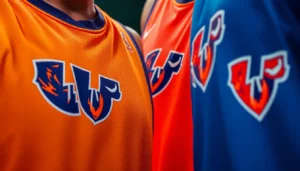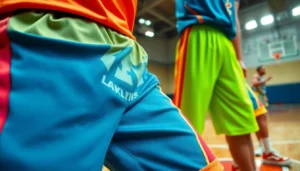Understanding the Essentials of Basketball Uniforms
Basketball uniforms are more than just clothing; they are a vital component of team identity, performance, and tradition. Over the years, these garments have evolved from simple jerseys and shorts into sophisticated equipment designed to enhance athletic performance while representing team spirit. For teams seeking to make a strong statement on the court, understanding the key elements, history, and innovative fabric technologies behind basketball uniforms is essential. To explore more about the diverse options and customization possibilities, visit Basketball Uniforms.
History and Evolution of Basketball Uniforms
The origins of basketball uniforms trace back to the early 20th century, where players wore woolen shirts and baggy shorts. As the sport gained popularity, the uniforms transitioned to lighter materials, emphasizing mobility and comfort. The 1960s and 70s marked significant innovations, including the adoption of jersey numbers and team logos. Modern uniforms now incorporate advanced fabrics that wick sweat, improve breathability, and offer enhanced durability.
Recent trends have seen a shift toward personalized designs, vibrant color schemes, and lightweight, stretchable materials that promote unrestricted movement. The evolution of basketball uniforms reflects a continuous pursuit of combining functionality with style, ensuring players perform at their peak while showcasing team identity.
Key Components of a Modern Basketball Uniform
A typical basketball uniform consists of several critical elements:
- Jersey: The centerpiece of the uniform, featuring the player’s number, team logo, and often the last name. Modern jerseys utilize sublimation printing for vibrant, durable designs.
- Shorts: Designed to provide mobility and comfort, often with adjustable waistbands and moisture-wicking fabric.
- Socks and Shoes:
- Additional Accessories: Items like arm sleeves, headbands, or compression gear may also be part of a player’s ensemble.
Complementary gear that influences performance and injury prevention.
Attention to detail in each component enhances overall performance and team cohesion. For example, seamless jersey stitching reduces chafing, while lightweight shorts improve agility.
Materials and Fabric Technologies for Comfort and Performance
The backbone of high-performing basketball uniforms lies in their materials. Advanced fabric technologies focus on moisture management, durability, and flexibility:
- Sublimated Polyester: Used for vibrant, long-lasting prints, and excellent moisture-wicking properties.
- Poly-knit and Poly-mesh Fabrics: Offer breathability and stretchability, crucial for high-intensity gameplay.
- Pro-wick and Pro-elite Fabrics: Special textiles that actively pull sweat away from the skin, keeping athletes dry and comfortable.
When selecting materials, consider factors such as climate, player size, and activity level. For instance, lighter fabrics are excellent for indoor courts, while more durable textiles may be needed for outdoor play.
Designing Your Custom Basketball Uniforms
Choosing Colors, Logos, and Team Names
Designing a memorable uniform starts with selecting colors that resonate with your team’s identity and evoke team spirit. Bright colors like red, blue, or neon shades are eye-catching, while darker hues convey strength and professionalism. Incorporating your team logo and name into the design reinforces branding consistency. Logos should be scalable for various uniform parts and prepared in high-resolution formats suitable for sublimation printing.
Incorporating Player Numbers and Personalization
Player numbers are essential for identification and officiating, requiring clear visibility. Popular placements include the front and back of jerseys, with font styles that complement overall design aesthetics. Personalization options extend beyond numbers to include names, nicknames, or individual insignia, fostering a sense of belonging and pride among players.
For youth or recreational teams, reversible jerseys with customizable side designs and reversible numbers are gaining popularity, offering versatility and value.
Design Trends and Tips for a Unique Look
Current design trends emphasize minimalistic branding, bold patterns, and custom graphics. Incorporating unique elements such as custom stripes, gradient fades, or sublimated graphics can set your team apart. Tips include:
- Maintain color harmony and contrast for readability.
- Use high-resolution images and scalable vector graphics for clarity.
- Consider the psychological impact of color choices on team cohesion and opponent perception.
- Balance aesthetics with functionality—avoid overly heavy or restrictive designs.
Manufacturing and Ordering Process
Selecting the Right Supplier for Basketball Uniforms
Choosing a reliable manufacturer is critical to ensure quality, timely delivery, and customization options. Look for suppliers with a proven track record, certifications, and positive customer reviews. Many reputable companies, such as Wooter Apparel, offer extensive customization services and samples.
Cost Factors and Budget Considerations
Factors influencing costs include fabric selection, order quantity, complexity of design, and branding details. Bulk orders generally benefit from discounts, making large-team purchases more budget-friendly. Additional costs may arise from custom embellishments, tags, or specialized fabrics.
Setting a clear budget upfront helps in negotiating with suppliers and balancing quality with affordability.
Lead Times and Quality Assurance Tips
Manufacturing lead times vary, typically ranging from two to six weeks. To prevent delays, plan ahead, especially for tournaments or seasons. Ensure quality by requesting samples, inspecting fabric swatches, and reviewing manufacturing certifications. Clear communication regarding sizes, colors, and design specifications is vital for a smooth process.
Optimizing Performance with the Right Uniforms
Impact of Fit and Fabric on Player Mobility
An ill-fitting uniform can hamper movement and cause discomfort. Proper sizing, such as athletic cuts that accommodate different body types, enhances agility and reduces fatigue. Fabrics with stretch properties maximize range of motion, especially during high-intensity maneuvers like jumps and quick changes in direction.
Maintenance and Care for Longevity
Proper care extends the lifespan of basketball uniforms. Washing in cold water, avoiding harsh detergents, and air drying help maintain fabric integrity. Removing stains promptly and storing uniforms properly prevents fabric deterioration and color fading.
Player Feedback and Continuous Improvement
Regular feedback from players regarding fit, comfort, and durability informs future uniform designs. Incorporating their insights fosters a collaborative environment focused on performance optimization.
Maximizing Team Success with Apparel Choices
Aligning Uniforms with Team Identity and Spirit
Unified, well-designed uniforms boost team morale, foster pride, and intimidate opponents. Color schemes and branding elements should reflect the team’s ethos, values, and logo, creating a cohesive visual identity that extends beyond the court.
Case Studies: Successful Uniform Branding
Many professional teams leverage uniform design to reinforce brand recognition. For example, the Chicago Bulls’ iconic red and black colors, and the detailed customization seen in high school or collegiate teams, demonstrate the power of thoughtful apparel choices in building a formidable team image.
Future Trends in Basketball Uniform Technology
Advancements include smart textiles embedded with sensors for real-time performance metrics, eco-friendly materials for sustainability, and innovative dyeing techniques for more vibrant, detailed designs. Staying ahead of these trends ensures your team maintains a competitive edge both in performance and style.


